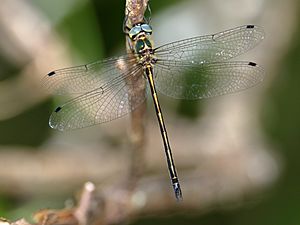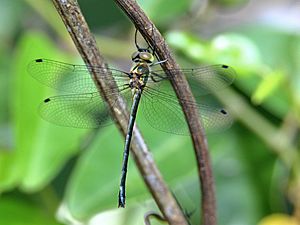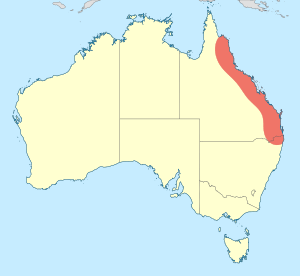Forest mosquitohawk facts for kids
Quick facts for kids Forest mosquitohawk |
|
|---|---|
 |
|
| Male Cairns, Australia. | |
 |
|
| Female | |
| Conservation status | |
| Scientific classification | |
 |
The Forest mosquitohawk (scientific name: Micromidia atrifrons) is a fascinating type of dragonfly. It belongs to the family Austrocorduliidae. This dragonfly is small to medium-sized. It has a striking appearance, with colors ranging from black to metallic green. You can also spot pale markings on its body, especially on its abdomen.
This special dragonfly lives only in north-eastern Australia. When an animal or plant lives only in one specific area, we call it endemic to that place. The Forest mosquitohawk loves to live near streams.
Contents
Meet the Forest Mosquitohawk
Dragonflies are amazing insects. They are known for their beautiful wings and incredible flying skills. The Forest mosquitohawk is no exception. It is a swift flyer, darting around its watery home.
What Does It Look Like?
The Forest mosquitohawk has a body that can be black or shiny metallic green. It also has lighter marks on its abdomen. These marks help it blend in or stand out, depending on its needs.
Male vs. Female
Like many dragonflies, male and female Forest mosquitohawks can look a bit different. The images in the infobox show a male and a female. You can see the subtle differences in their colors and patterns.
Where Does It Live?
The Forest mosquitohawk makes its home in north-eastern Australia. It prefers areas with streams. These streams provide the perfect habitat for dragonflies. They need clean water for their young to grow.
Life in the Stream
Young dragonflies, called nymphs, live underwater. They breathe through gills and hunt tiny water creatures. When they are ready, they climb out of the water. Then, they shed their skin one last time to become adult dragonflies.
Dragonfly Family Tree
Scientists sometimes debate where certain species fit in the animal kingdom. For the Forest mosquitohawk, there's a bit of a puzzle. Scientists are still figuring out if it best belongs to the Austrocorduliidae, Synthemistidae, or Corduliidae families. This shows how science is always learning new things!
Images for kids







